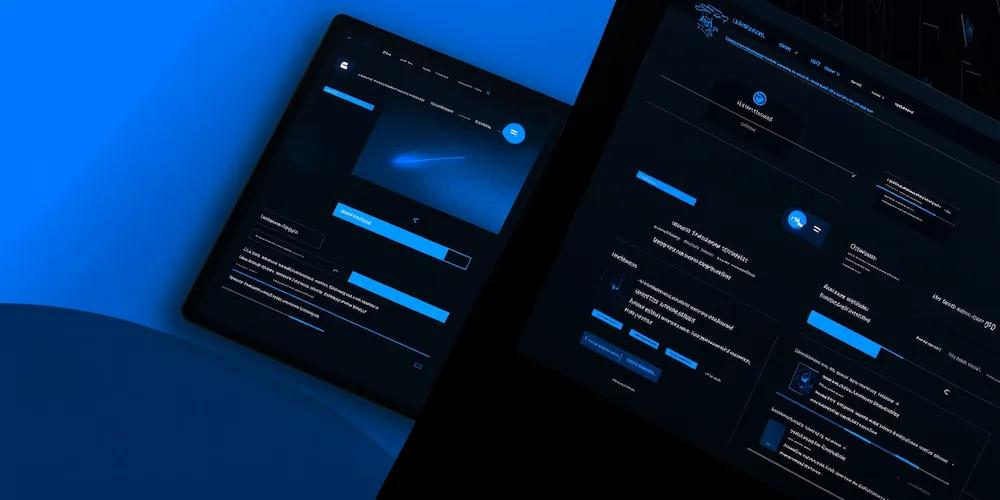In this guide on fintech website redesign we dive into essential strategies for enhancing user experience, ensuring security, and optimizing functionality. We will share that all while showcasing real-world redesigns that have driven significant business growth.

7 Best Practices for Fintech Website Redesigns
To outperform your competitors, explore these best practices for fintech website redesigns.
1. User-Centric Design
In the competitive fintech landscape, user-centric design strategies are more than a trend—they're a necessity. User-centric design prioritizes understanding and addressing user needs, ensuring seamless interactions with financial services.
Understanding User Needs
User needs form the foundation of user-centric design. Fintech companies must invest time in researching their audience, understanding pain points, and crafting solutions that align with their expectations. Stripe, a fintech leader, excels in this area by designing its website around the user journey. Its clean layout, intuitive navigation, and easy access to documentation demonstrate a commitment to making complex financial processes simple and accessible.
By using tools like user personas and journey mapping, fintech businesses can ensure their platforms are built to meet diverse customer requirements.
Creating Intuitive Interfaces
After understanding user needs, the next step is crafting intuitive interfaces. Intuitive interfaces should minimize cognitive load, avoid industry jargon, and focus on clarity. Robinhood sets a prime example by simplifying stock trading for beginners. Its uncluttered design and user-friendly onboarding process ensure accessibility without overwhelming new users.
Fintech platforms can adopt similar strategies by using visual hierarchies, consistent color schemes, and responsive layouts to guide users through their journeys. For a comprehensive overview, refer to our fintech UX design guide.
Testing and Iterating on Designs
Effective user-centric design requires continuous testing and iteration. Platforms like PayPal and Square lead the way, employing tools like heatmaps, A/B testing, and user feedback loops to optimize designs. By regularly testing new features and refining existing ones based on data, they ensure their websites remain aligned with evolving user expectations.
Fintech companies should incorporate agile methodologies to make testing an ongoing process, allowing for faster adaptation to user needs. Utilizing website design collaboration tools can streamline this iterative process.
2. Security and Trust
In fintech, trust is paramount. Users entrust these platforms with sensitive information, and ensuring their data's safety is crucial to building loyalty and confidence.
Understanding Security Risks
Security risks in fintech range from data breaches to non-compliance with industry standards. Even a minor security lapse can lead to significant reputational damage. Companies like Wise demonstrate how addressing these risks upfront helps mitigate threats. Their robust encryption protocols and multi-factor authentication systems provide a strong line of defense against potential vulnerabilities.
Implementing Best Practices for Data Protection
Best practices for securing fintech websites include implementing SSL encryption, compliance with regulations like GDPR, and using firewall protection systems. Stripe has set the benchmark here, maintaining compliance with industry standards like PCI DSS and ensuring all data is securely stored and transmitted.
For fintech businesses, integrating security tools like Cloudflare for web protection and regularly conducting penetration tests are key steps in strengthening security measures.
Building Customer Trust through Transparency
Transparency builds trust. Users are more likely to engage with platforms that clearly communicate how their data is protected. For example, Wise displays its security features prominently and uses plain language to explain data usage and fees. By adopting similar brand consistency strategies, fintech companies can foster stronger relationships with their users.
Adding trust badges, dedicated security pages, and testimonials can further enhance credibility and reassurance.
3. Clear Communication and Messaging
Fintech services often deal with complex concepts, making clear communication essential for user understanding and trust.
Importance of Clear Communication
Simplifying financial jargon into straightforward language ensures users can easily grasp a platform's value proposition. Robinhood exemplifies this by using concise, benefit-driven messaging that resonates with its audience. Their homepage immediately highlights their mission—making investing accessible—without overwhelming users with unnecessary details.
Strategies for Effective Messaging
To craft effective messaging:
- Focus on benefits rather than features. For instance, Square emphasizes "effortless payments" rather than technical specifications.
- Use strategically placed calls-to-action (CTAs) to guide users through desired actions, such as signing up or exploring features.
By employing concise language and focusing on user benefits, fintech platforms can create compelling messages that resonate with their target audience.
Tools for Enhancing Communication
Interactive elements like tooltips, pop-ups, and infographics can break down complex information. For example, visual guides on investment growth, transaction security, or loan calculations make content engaging and easier to understand.
Fintech companies can use tools like Canva for designing infographics or Hotjar to track how users interact with informational content, ensuring clarity and retention.
4. Responsive Mobile-First Design
As more users rely on mobile devices for financial transactions, a mobile-first indexing guide has become a critical component of fintech website redesigns.
Understanding Mobile-First Approach
A mobile-first approach involves designing for smaller screens first, then scaling up for larger devices. This ensures critical functionalities remain accessible and usable across all platforms. Revolut has mastered this approach, providing a seamless mobile experience with optimized navigation, clear typography, and actionable CTAs tailored for smaller screens.
Benefits of Responsive Design
Responsive design improves user satisfaction by ensuring websites adapt seamlessly to any device. Additionally, mobile-friendly designs tend to perform better in SEO rankings, further enhancing visibility and engagement. For instance, N26 offers consistent performance whether accessed via smartphone, tablet, or desktop.
Best Practices and Tools for Mobile-First Implementation
Key practices include:
- Prioritizing readable fonts and tappable buttons.
- Simplifying navigation for touch interfaces.
- Optimizing images for faster load times on mobile networks.
Use tools like Bootstrap or Tailwind CSS to build responsive layouts quickly and efficiently. Refer to our responsive design checklist to ensure all aspects of mobile design are covered.

5. Intuitive Navigation and User Flows
Navigation is the backbone of a fintech website. Intuitive paths ensure users can achieve their goals without frustration.
Understanding User Behavior
Understanding user behavior is key to creating intuitive navigation. Tools like Google Analytics and Hotjar offer insights into user interactions, such as drop-off points or frequently accessed features. By studying these patterns, fintech companies can identify pain points and adjust navigation accordingly.
Designing Clear Navigation Paths
Clarity is critical in navigation design. Wise, for example, limits top-level categories to essentials, making it easy for users to locate features like "Send Money" or "Track Transfer." Drop-down menus, when used sparingly, further streamline access without overwhelming users.
Implementing Effective User Flows
Logical user flows ensure that key tasks, such as transferring funds or checking balances, are completed efficiently. Visual cues like progress bars, breadcrumbs, and persistent navigation bars guide users, reducing confusion. Testing flows with real users ensures designs meet their intended goals. For more insights, explore our guide on intuitive navigation design.
6. Interactive Tools and Data Visualization
Interactive tools enhance user engagement by transforming complex data into actionable insights.
Importance of Interactive Tools in Data Analysis
Fintech platforms like Betterment provide users with interactive tools such as portfolio analyzers and goal-setting wizards. These tools simplify financial planning, making data actionable and relevant to users’ personal goals.
Popular Data Visualization Libraries
Libraries like D3.js and Chart.js allow fintech platforms to create interactive charts that make complex datasets comprehensible. For example, visualizing spending habits through dynamic pie charts helps users track expenses with ease.
Best Practices for Interactive Visualizations
Keep visualizations user-centric:
- Simplify overly complex graphs.
- Ensure responsiveness across devices.
- Use consistent color schemes for clarity.
By using these tools and adhering to best practices, fintech companies can present data in a way that informs and delights users. Incorporating motion design benefits can further enhance user engagement.
7. Fast Performance and Page Speed
Website speed is a critical component of user experience, particularly in fintech where delays can erode trust.
Importance of Page Speed for User Experience
Fast-loading pages improve engagement, satisfaction, and conversion rates. In fintech, where transactions and financial insights need to be immediate, speed is non-negotiable.
Techniques to Improve Website Performance
Optimizing images, minimizing file sizes, implementing caching strategies, and using scalable architectures are proven techniques for enhancing performance. Employing content delivery networks (CDNs) further ensures fast load times globally. For comprehensive strategies, consider our guide on website performance optimization.
Tools for Measuring Page Speed
Tools like Google PageSpeed Insights and GTMetrix provide actionable insights into performance bottlenecks, helping teams refine and optimize site functionality. Understanding different CMS options comparison can also influence page speed and performance.
By prioritizing speed and performance optimization, fintech companies can deliver seamless experiences that retain users and build trust.
Examples of Successful Fintech Website Redesigns
Successful fintech website redesigns show how a well-planned digital strategy can transform user experience, build trust, and drive business growth. Below are detailed insights into notable examples and measurable results achieved through effective redesigns.
- Robinhood: The Robinhood redesign centered on simplifying complex financial operations. By focusing on user-centric layouts, they eliminated clutter, resulting in a 20% increase in app downloads and higher engagement rates among new users.
- Stripe: Known for its developer-friendly approach, Stripe enhanced its redesign by offering tailored user journeys. The redesign included a comprehensive documentation hub that boosted integration speeds for partners by 30%.
- Wise (formerly TransferWise): Wise revamped its website to emphasize transparency and usability. Interactive fee calculators on the homepage helped users quickly understand costs, contributing to a 15% rise in customer conversions.
- PayPal: PayPal’s redesign optimized performance for mobile devices. The simplified checkout process led to an 18% increase in completed transactions, solidifying its position as a leader in mobile payments.
- Betterment: Betterment integrated advanced data visualizations in its redesign, offering users greater insight into their financial progress. As a result, Betterment experienced a 25% improvement in user retention and elevated customer satisfaction scores.
Results and Improvements from Redesigns
Successful redesigns lead to measurable outcomes, including:
- Enhanced User Experience: Redesigned interfaces improve navigation, accessibility, and overall usability, keeping users engaged longer.
- Increased Conversions: Clear calls-to-action and streamlined user flows lead to higher sign-ups and transactions.
- Improved Brand Perception: A modern, polished website reflects innovation and reliability, attracting a broader audience.
- Higher Retention Rates: Engaging tools and seamless navigation create loyal users who return for their financial needs.
For example, Robinhood's intuitive interface attracted more first-time investors, while Stripe’s enhanced developer tools strengthened partnerships. Similarly, Wise's transparent design fostered trust, and PayPal’s mobile optimization broadened its global user base.
Transforming Your Fintech Website for 2025
As fintech companies look to the future, redesigning websites with a focus on user-centric design, security, clear communication, responsive design, intuitive navigation, interactive tools, and fast performance is vital. By following these best practices and learning from successful redesign examples, you have a blueprint for creating a digital presence that drives business growth.




